#Songs Composed by Sanjay Leela Bhansali
Explore tagged Tumblr posts
Text
Bajirao Mastani: The Plight of the Cheating Husband
Follow me on Instagram: @thatguyanesejournalist
Let’s talk about Sanjay Leela Bhansali’s Bajirao Mastani.
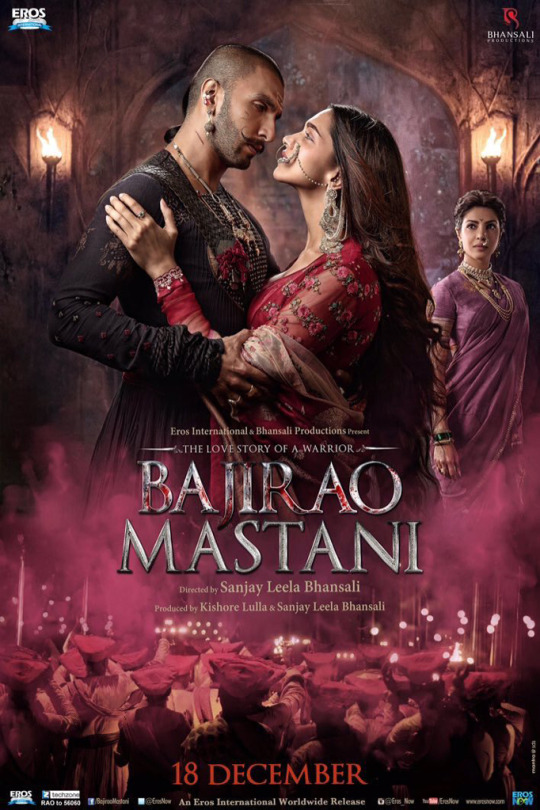
Bajirao is a Hindu Peshwa (minister to the king of the Maratha empire) who falls in love with Mastani, a Muslim warrior princess, while married to his wife Kashibai. The movie centers around Bajirao and Mastani’s interfaith relationship and the opposition against it from Bajirao’s conservative Hindu family.

I would like to start off this post by saying I support polygamy/polyamory, just not in the way it’s presented here. Let’s call it like it is: Bajirao and Mastani’s relationship would be cute as hell if he wasn’t cheating on his wife. I’d like to give Mastani the benefit of the doubt and say she initially didn’t know Bajirao was married, but I don’t think that would’ve stopped her since she still accepted his condition that Kashi will always remain his first wife.
One thing I admire the film for doing is creating sympathy for Kashibai, especially in her and Bajirao’s last scene together in her bedchambers (one of my favorite scenes in the film). She didn’t ask for much, but ended up expecting very little from her husband in the loyalty department.
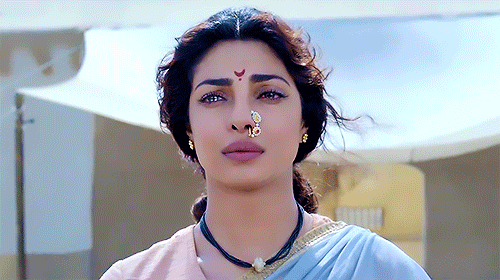
I’ll be honest, though, I adored Mastani’s character. She was strong and independent, even fighting side-by-side with Bajirao in the war. She wanted a man, but didn’t necessarily need one. While I don’t agree with her going all the way to Pune for him, Mastani clearly showed that she’s determined to get what she wants and will find multiple methods to achieve it.
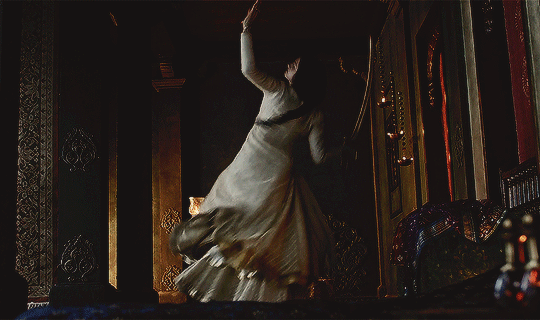
Plot aside, I absolutely loved the movie. Not only were there two strong female characters that I felt were well-developed as the movie went on, but the dialogue is on a different level of poetic and impactful at the same time. It makes you cry (or was it just me?) when mixed with the grand visuals and subtle but emotionally moving acting performances. Here are some of my favorite lines/moments:
“I cherish your every offering, be it an anklet or a son.” - Mastani
“Perhaps you forget that idols in temples are often adorned in green and saffron sheets cover the purest Sufi tombs. Where is the thought of color and religion then?” - Mastani
The scene where Mastani fights people in Mastani Mahal, holding her son in one hand and a sword in the other (makes me think of the Goddess Durga)
The entire ending where Bajirao is fighting his inner demons in the river (one of the most visually meaningful/cinematic scenes I’ve seen)
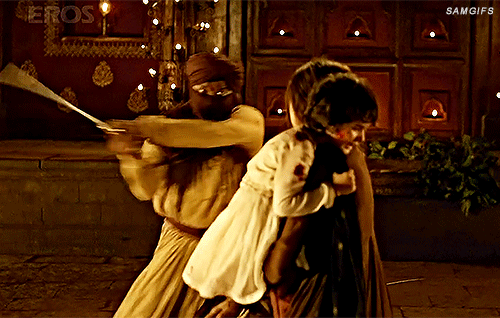
To me, there are no misses on the soundtrack, which was composed by Bhansali and Sanchit Balhara. In fact, I had a hard time curating the song suggestion list but I decided to pick the songs I ended up drifting towards.
Mohe Rang Do Laal (it gives me "Kaahe Chhed Mohe" vibes, Deepika's dance in this song is very graceful imo)
Aaj Ibaadat
Aayat
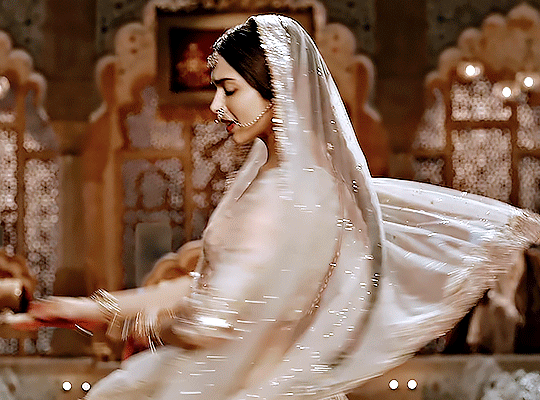
The movie is 158 minutes long (2 hours and 38 minutes). Stream it here, grab a snack, and enjoy!
If you like (or don’t like) this format of blog posts, let me know in the comments!
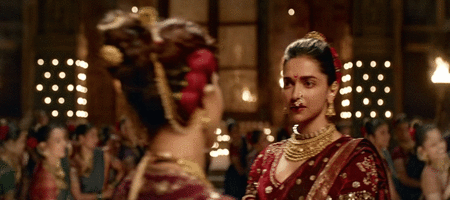
#indian#bollywood#ranveersingh#deepikapadukone#priyanka chopra#ranveer deepika#bajirao mastani#historical#films#movies
14 notes
·
View notes
Text
Shreya Ghoshal’s Global Impact: Taking Indian Music to the World
Shreya Ghoshal is a name that resonates with every music lover, not just in India but worldwide. With her soulful voice and an ability to deliver emotions through her singing, Shreya has become one of the most celebrated playback singers in Indian music. From being a small-town girl with dreams of making it big to becoming a global icon, her journey is nothing short of inspiring. This article delves into the incredible evolution of Shreya Ghoshal, exploring the milestones, challenges, and triumphs that have defined her remarkable career.
The Early Years: A Prodigy in the Making
Born on March 12, 1984, in Berhampore, West Bengal, Shreya was destined for musical greatness. Her family recognized her talent early on, and by the age of four, she was already being trained in classical music. Growing up in Rawatbhata, Rajasthan, she imbibed a love for traditional Indian music, which would later become the foundation of her versatile singing style.
Shreya’s parents played a pivotal role in nurturing her talent. Her mother often practiced with her, while her father, an engineer by profession, ensured she had the best training. She studied under her first guru, Mahesh Chandra Sharma, where she honed her classical skills and competed in numerous local competitions.
The Turning Point: Reality TV Success
Shreya’s life changed forever when she participated in the television reality show Sa Re Ga Ma Pa at the age of 16. Her soulful renditions on the show caught the attention of filmmaker Sanjay Leela Bhansali, who was looking for a fresh voice for his upcoming movie Devdas. Her performance on the show was so impactful that Bhansali personally reached out to her and offered her the opportunity to be the voice of Paro.
This was a defining moment for Shreya. The songs from Devdas, including “Bairi Piya,” “Dola Re Dola,” and “Silsila Ye Chahat Ka,” catapulted her to instant fame. She not only won the National Film Award for Best Female Playback Singer but also proved her mettle as a versatile and emotive singer. The film’s soundtrack remains iconic to this day, with Shreya’s voice as one of its standout features.
Establishing Herself in Bollywood
Post-Devdas, Shreya became a household name, and there was no looking back. She worked with some of the most prominent music directors, including A.R. Rahman, Pritam, and Vishal-Shekhar. Her ability to adapt to various musical styles, whether it was a classical piece or a contemporary track, made her a favorite among composers.
Songs like “Jaadu Hai Nasha Hai” (Jism), “Teri Ore” (Singh Is Kinng), “Piyu Bole” (Parineeta), and “Sun Saathiya” (ABCD 2) further established her as a versatile artist capable of delivering hits across genres. Whether it was romantic ballads, peppy dance numbers, or soulful ghazals, Shreya’s voice became synonymous with perfection.
Conquering Regional and Global Music
One of Shreya’s unique qualities is her ability to sing in multiple languages. Over the years, she has sung in more than 20 Indian languages, including Bengali, Tamil, Telugu, Kannada, Marathi, and Malayalam. Her linguistic versatility has endeared her to audiences across India, making her one of the most sought-after playback singers in the industry.
Her global appeal was recognized when the state of Ohio, USA, declared June 26 as Shreya Ghoshal Day in 2010. This acknowledgment was not just a testament to her talent but also to her role in representing Indian music on the global stage.
Adapting to Changing Trends
As the music industry evolved with the advent of streaming platforms and independent music, Shreya adapted seamlessly. While she continues to dominate as a playback singer, she has also ventured into independent music projects. Her singles, such as “Tere Bina” and “Angana Morey,” showcase her versatility and willingness to explore new territories.
Shreya’s live performances have also become a significant aspect of her career. Her concerts, both in India and abroad, are known for their energy, emotion, and connection with the audience. These performances allow her fans to experience her magic in a more personal and intimate setting.
Accolades and Legacy
Shreya Ghoshal’s illustrious career is adorned with numerous accolades, including four National Film Awards, seven Filmfare Awards, and several state awards. She has consistently been featured in Forbes India’s Celebrity 100 list, highlighting her influence in the entertainment industry.
However, her most significant achievement lies in the hearts of her fans. Her voice has been a constant companion for millions, accompanying them through moments of joy, love, heartbreak, and nostalgia.
Conclusion: An Enduring Icon
Shreya Ghoshal evolution from a small-town girl to a global music icon is a story of talent, perseverance, and passion. Her ability to adapt to changing times while staying true to her classical roots has made her a timeless figure in the world of music.
Even after two decades in the industry, Shreya continues to inspire young musicians and bring joy to her listeners. Her journey is a testament to the fact that with talent, hard work, and dedication, dreams can indeed come true.
To experience the magic of Shreya Ghoshal’s voice, explore her discography on platforms like Spotify, Apple Music, and YouTube. Follow her on social media to stay updated on her latest projects, and don’t miss the chance to attend her live performances for an unforgettable experience. Let her music inspire and accompany you on your journey through life.
0 notes
Text
EK BAAR DEKH LIJIYE LYRICS - Heeramandi
Ek Baar Dekh Lijiye (एक बार देख लीजिये) Lyrics from Heeramandi is brand new english song sung by Kalpana Gandharva while this latest song is featuring Taha Shah, Sharmin Segal. Ek Baar Dekh Lijiye song lyrics are penned down by A.M Turaz while music composed by Sanjay Leela Bhansali and video has been directed by Sanjay Leela Bhansali.
0 notes
Text
Songs
��Here you will find the lyrics of the popular song – “Aazadi ” from the Movie / Album – “Heeramandi”. The Music Director is “Sanjay Leela Bhansali”. The song soundtrack was composed by the famous lyricist “A M Turazl” and was released on “04-29-2024” in the beautiful voices of “Archana Gore, Aditi Prabhudesai, Aditi Paul, Dipti Rege, Pragati Joshi”. The song's music video features some amazing and talented actors/actresses “Manisha Koirala, Sonakshi Sinha, Aditi Rao Hydari, Richa Chadha, Sanjeeda Sheikh, Sharmin. It was released under the “Bhansali Productions Music”.
0 notes
Text
Aaj Main Upar Piano Notes | Khamoshi: The Musical

Aaj Main Upar Piano Notes
Notes :- Aaj main upar, Aasmaan neeche C5# B4 A4 G4# A4 A4, C5# B4 A4 G4# A4 A4 Aaj main aage, Zamaana hai peechhe.. E4 F4# G4 A4 G4 F4#, D4 D4 F4# D4 E4 A4 A4 C5# Aaj main upar, Aasmaan neeche C5# B4 A4 G4# A4 A4, C5# B4 A4 G4# A4 A4 Aaj main aage, Zamaana hai peechhe.. E4 F4# G4 A4 G4 F4#, D4 D4 F4# D4 E4 A4 A4 A4 B4 A4 G4# Tell me o khuda, music F4# F4# C5# F4# F4#, D4 E4 F4# A4 F4# Ab main kya karoon, music F4# F4# D5 F4# F4#, D4 E4 F4# A4 F4# Chaloon seedhi ki ulti chaloon F4# G4# A4 B4 B4 B4 C5# B4 A4 G4# A4 A4 C5# Aaj main upar, Aasmaan neeche C5# B4 A4 G4# A4 A4, C5# B4 A4 G4# A4 A4 Yunhi bin baat ke, Chhalke jaaye hansi A4 C5# C5# D5 E5 C5#, A4 C5# C5# D5 E5 C5# Dole jab hawa, Laage gudugudi C5# D5# D5# C5# B4, B4 B4 B4 A4 G4# A4 G4# Yunhi bin baat ke, Chhalke jaaye hansi A4 C5# C5# D5 E5 C5#, A4 C5# C5# D5 E5 C5# Dole jab hawa, Laage gudugudi C5# D5# D5# C5# B4, B4 B4 B4 A4 G4# A4 G4# Sambhaloon gir padoon, music F4# F4# C5# F4# F4#, D4 E4 F4# A4 F4# Tauba kya karoon, music F4# F4# D5 F4# F4#, D4 E4 F4# A4 F4# Chaloon seedhe ki ulti chaloon F4# G4# A4 B4 B4 B4 C5# B4 A4 G4# A4 A4 C5# Aaj main upar, Aasmaan neeche C5# B4 A4 G4# A4 A4, C5# B4 A4 G4# A4 A4
About Song :-
"Aaj Main Upar" is a popular Hindi song from the Bollywood movie "Khamoshi: The Musical," which was released in 1996. The film was directed by Sanjay Leela Bhansali and starred Manisha Koirala, Nana Patekar, Salman Khan, and Seema Biswas in lead roles. The music for the film was composed by Jatin-Lalit, and the lyrics for this particular song were written by Majrooh Sultanpuri. Here are some details about the song "Aaj Main Upar": Song Title: Aaj Main Upar Singers: Kavita Krishnamurthy and Kumar Sanu Music: Jatin-Lalit Lyrics: Majrooh Sultanpuri Film: Khamoshi: The Musical (1996) Actors: Manisha Koirala, Nana Patekar, Salman Khan, and others Plot: "Aaj Main Upar" is a cheerful and uplifting song featured in the film. The song is picturized on the character played by Manisha Koirala and celebrates life and joy. It has a lively and festive atmosphere. The song is known for its catchy composition by Jatin-Lalit and the spirited vocal performances by Kavita Krishnamurthy and Kumar Sanu. It stands out for its celebratory and feel-good vibes. "Khamoshi: The Musical" is a drama film that explores themes of love, family, and relationships. The film received positive reviews for its music, performances, and storytelling. "Aaj Main Upar" remains a popular and memorable track in the world of Bollywood music. It is often appreciated for its music, lyrics, and the lively picturization in the film. Read the full article
0 notes
Text
A Spectacle of Royal Romance: Bajirao Mastani
Bajirao Mastani is a historical romance film from Bollywood, released in 2015. Directed by Sanjay Leela Bhansali, the film depicts the legendary love story of Maratha warrior Peshwa Bajirao and his second wife, Mastani. This essay will focus on the key aspects of the film, including its historical backdrop, visual grandeur, powerful performances, and cultural impact.
Firstly, Bajirao Mastani is set in the 18th century and presents a captivating glimpse into the historical context of the Maratha Empire, highlighting the bravery and political strategies of Peshwa Bajirao. The film draws heavily from historical accounts, beautifully showcasing the vibrant costumes, authentic sets, and the overall atmosphere of that era. The screenplay balances the historical events with the love story of Bajirao and Mastani, creating a compelling and engaging narrative.
Secondly, the visual grandeur of Bajirao Mastani is a testament to the director's artistic vision. Sanjay Leela Bhansali, known for his visually stunning films, has spared no effort in creating a visually breathtaking cinematic experience. The film showcases grand sets, intricately designed costumes, and elaborate choreography. The use of vibrant colors, detailed craftsmanship, and extravagant dance sequences adds an opulent touch to the film, mesmerizing the viewers with its visual splendor.
Furthermore, the performances in Bajirao Mastani are remarkable, with Ranveer Singh, Priyanka Chopra, and Deepika Padukone delivering stellar performances. Ranveer Singh shines as Peshwa Bajirao, capturing his charisma, valour, and vulnerability with great depth. Deepika Padukone brings grace and strength to her role as Mastani, effortlessly portraying her love, resilience, and resilience. Priyanka Chopra, in the role of Kashibai, Bajirao's first wife, delivers a remarkable performance, showcasing a range of emotions and complexities.
Lastly, Bajirao Mastani has had a significant cultural impact, both within India and internationally. The film was praised not only for its cinematic brilliance but also for its portrayal of a historical love story that was relatively unknown to a wider audience. It received critical acclaim and numerous awards, including several National Film Awards. The music of the film, composed by Sanjay Leela Bhansali himself, was a commercial success, with songs like "Deewani Mastani" becoming popular chartbusters.
In conclusion, Bajirao Mastani is a cinematic masterpiece that combines history, visual grandeur, powerful performances, and cultural impact. It transports the viewers to the 18th century Maratha Empire, providing an insight into the historical events while beautifully weaving a heart-wrenching love story. Sanjay Leela Bhansali's artistic vision, along with the impeccable performances of the cast, creates a mesmerizing cinematic experience. The film's cultural impact and critical acclaim further solidify its status as a remarkable Bollywood film.
0 notes
Text
Lyrics Binte Dil
Lyrics in English | Binte Dil Misiriya Me | Padmaavat-2018 | Ranveer Singh Binte DilMisiriya MeBinte DilMisiriya MeBinte DilMisiriya MeBinte DilMisiriya MePesh Hai KulluShabaab Khidmat-E-Aali JanaabPesh Hai KulluShabaab Khidmat-E-Aali JanaabAatish KadaAdaayon SeAatish KadaAdaayon SeJal Uthega Aap KeDee-Da-E-Tar Ka HijaabBinte DilMisiriya MeBinte DilMisiriya Me………. Antakshari Songs from…
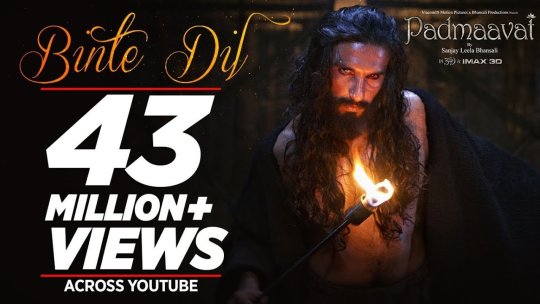
View On WordPress
#All Time Best Songs Composed by Sanjay Leela Bhansali#All Time Best Songs of Ranveer Singh#All Time Best Songs Written by A M Turaz#Antakshari Songs from B#Arijit Singh Solo Songs#Arijit Singh Songs#Best 50 Songs of Arijit Singh#Best 50 Songs of Ranveer Singh#Best Bollywood Songs of 2018#Best of Arijit Singh#Best Romantic Songs of Ranveer Singh#Best Sad Songs of Ranveer Singh#Best Solo Songs of Arijit Singh#Best Songs of 2018#Best Songs of Arijit Singh#Best Songs Written by A M Turaz#Bollywood Songs of 2018#Hindi Song Lyrics Starting from B#Hindi Songs of 2018#Lyrics Starting from B#Ranveer Singh Songs#Songs Composed by Sanjay Leela Bhansali#Songs from Padmaavat (2018)#Songs Starting from "B"#Songs Written by A M Turaz#Superhit Songs of 2018#Top 100 Songs Arijit Singh#Top 20 Romantic Songs of Ranveer Singh#Top 20 Sad Songs of Ranveer Singh#Top 25 Songs Composed by Sanjay Leela Bhansali
0 notes
Text
★ Prabhudheva: Even I am cool, but Salman Khan sir is cooler!
Dec 9, 2019

Prabhudheva on his equation with the actor, with whom he has signed a third fi lm even before release of new Dabangg The successful duo of Salman Khan and Prabhudheva, who had earlier collaborated onWanted, which resurrected the former’s career after a dry spell, are back for the second time to carry forward one of Bollywood’s most successful franchises, Dabangg. With less than two weeks to go before the third instalment unfolds, the 46-year-old director admits he is nervous. After 25 years in showbiz? “Yeah, the only thing that has changed in all these years is that from the outside, I look composed, but inside it’s still the same,” he laughs. What changes has he noted in Salman since they first worked together? “There are changes in him as an actor; he knows everything about the film and not just story and screenplay. But personally, he is still the same,” Prabhu shares. And has the equation between them changed? “There is huge respect for each other,” he says, adding that their contrasting personalities make their combination work. Talking about Dabangg, the story and the characters come with certain preconceived notions and attitude. How did his distinctive style gel with what was on the template? “I don’t know how, but it mixed well and is visible on screen. I believe that the story and screenplay lead the director, and except for tweaking my style slightly to accommodate Chulbul Pandey’s antics, I didn’t have to adjust much,” Prabhu smiles, pointing out that the actor, who has been enacting this character for nine years now, knows him way better and also how to play him the best. There have been speculations around Sonakshi Sinha’s Rajjo, with many believing that this time around, she will be seen as a mother with a young son. On this, Prabhu is reticent, saying it is something for which audience will have to watch the film. But he confirms that Sona is playing a “young mother”. He is all praise for the film’s second leading lady, Saiee Manjrekar. “She is a new girl. So, she was curious about whatever we did. When we tied her or put glycerine in her eyes, Siaee wanted to know why we were doing so and what had happened to justify it on screen. It’s a normal reaction, and given the innocence of her face, she didn’t have to act much. Her face is her asset; plus, she is a hard worker and a born star like so many others of her generation,” he applauds, pointing out that youngsters today are so brilliant that you just need to guide them a bit and they will pave their own way. “By the second or the third film, they will be teaching us.” Dabangg is known for its chartbusters and hook steps. Prabhudheva, too, is known for his moves. How did the idea of taking the belt off, followed by the hip-swing (for “Munna Badnaam Hua”), come about? “The bulb in my head just went on,” he grins. “Salman comes up with different ideas, too. He showed me the move from “Hud Hud Dabangg” and I was like, ‘what is happening,’ because I couldn’t see anything moving... till he asked me to look down at the hips,” he guffaws. Prabhu is involved in “Munna Badnaam Hua” not just as a director and choreographer, but he also features in it. After dancing with Madhuri Dixit and Sonakshi, how was it matching steps with Salman again? “As a choreographer, I have worked with all kinds of dancers. Each of them has their own style and that’s why we like them. I enjoyed working with Salman, I didn’t face any difficulty,” he avers. Salman is known to have temper issues with directors. Recently, Inshaallah with Sanjay Leela Bhansali ground to a halt before it could take off. Meanwhile, Prabhu has worked with him in Wanted and Dabangg 3 and the duo has already kicked off a third film, Radhe. So far, it has been smooth sailing for them. What’s the secret? “It doesn’t happen with anyone,” Prabhu shrugs off the question, going on to rave about Salman’s big heart and how he can get reputed people on board his projects and at the same time help those not doing so well, hiring struggling actors for certain roles because they need work.
“I find it easy to work with sir because he listens to you when you tell him something isn’t going right and should be done differently. Even if the shoot runs late into the night, he doesn’t fuss about it. He is super cool. Even I am cool, but he is way cooler.”
He goes on to share an incident from the shoot of the Dabangg 3 climax. “It was a big and expensive set depicting a stone quarry. Sudeep (antagonist) had injured himself during a fight scene and was in pain. Everyone was worried because of the expenses, but in two seconds sir decided to cancel the shoot that day, saying the health and comfort of his team comes before anything else,” he marvels. The buzz in the industry today is that Salman likes Prabhudheva best, as he offered him Radhe while they were still working on Dabangg 3. It’s rare for him to start another film with the same director while still working on one. “His trust in me is unimaginable. I don’t need to say anything, he has proved it. Everybody knows now, and it makes me feel all the more responsible because with every step, I have to prove his trust right,” the filmmaker says earnestly. Prabhu is known to complete his films in three months and Salman is running on a tight schedule with Radhe, which he has announced as an Eid 2020 release. Could that be one of the reasons why the actor went with him? “Maybe,” Prabhu says. Radhe was being hyped as a sequel to Wanted, but later, it was clarified that the project is an official remake of the Korean film The Outlaws. However, Boney Kapoor has always said Wanted 2 will happen. Quiz Prabhu on the matter and he says, “Wanted is Salman and Boney sir’s project. Only they can decide when it will happen.” Apart from Radhe, the actorchoreographer-filmmaker has Street Dancer 3D, which is gearing up for a Republic Day 2020 release, as a cast member. Prod him on his part and he confides with an embarrassed laugh that even he doesn’t know the story. “When Remo (D’souza, director) calls next, I’ll have to ask him now,” he chuckles. The dance film features a recreation of his iconic song “Muqabala”. What was his reaction to it? “I can’t compete with (the ’90s) Prabhudheva,” he guffaws. “That is exactly what I told the makers when they asked me to perform on the new version.”
5 notes
·
View notes
Text

*Ghalib Hona Hai: Song from Sanjay Leela Bhansali’s original music album Sukoon trends at #2 on Aircheck Radio Top 20*
•Ghalib Hona Hai features Armaan Malik & Sharmin Segal
•Armaan Malik who forayed into Gazal with Ghalib Hona Hai wooed the audiences with his soothing voice.
•Ghalib Hona Hai is trending at #2 on AirCheck India T20
Sanjay Leela Bhansali’s music album Sukoon is creating a lot of buzz for bringing back the good old classical tunes with a modern feel, making the youth dwell in the magnetic world of Sukoon. The album is receiving tremendous love from all over the world for its melodious tunes and some of the best-known artists giving their voices to Sukoon. Each Ghazal tells its own story and at the same time brings calmness to your soul.
Recently, AirCheck India T20, a world leader in radio spot and music monitoring, providing services revealed the list of their top 20 songs for the week of 12-18th December and audiences love brought Ghalib Hona Hai to #2 in the list. The song is from Bhansali’s album Sukoon and features Armaan Malik and Sharmin Segal depicting a unique tale of one-sided love with utmost fineness making fans fall for their exceptional chemistry. Armaan Malik who forayed into Gazal with Ghalib Hona Hai wooed the audiences with his soothing voice.
Sanjay Leela Bhansali has always left the heart of audiences filled with love and admiration with every new project be it Goliyon ki Raasleela Ram- Leela, Bajirao Mastani, Padmaavat or Gangubai Kathiawadi. Now, with his first ever original music album, the director-cum music composer has brought back the essences and magic of Ghazals for the modern generation. Well truly, one cannot help but get mesmerised by all the songs from Sanjay Leela Bhansali’s album, Sukoon.
0 notes
Link
1 note
·
View note
Text
Sanjay Leela Bhansali’s Spotify Hits and Their Cultural Impact
In the vast and dynamic landscape of Indian cinema, a few names rise above the rest, leaving an indelible mark on the industry. One such name is Sanjay Leela Bhansali — a filmmaker whose dedication to storytelling, artistic vision, and unrelenting pursuit of perfection have cemented his legacy as one of the most influential figures in Bollywood. Known for his larger-than-life sets, emotionally charged narratives, and soulful music, Bhansali has redefined what it means to create cinema that is not just watched but felt.
From his directorial debut in Khamoshi: The Musical (1996) to his magnum opuses like Bajirao Mastani and Padmaavat, Bhansali has consistently pushed the boundaries of storytelling and production, setting new benchmarks for the industry. His films are more than just movies; they are cultural phenomena that reflect the essence of Indian heritage, emotion, and grandeur.
The Bhansali Aesthetic: Where Art Meets Storytelling
One of the most defining aspects of Bhansali’s work is his unique aesthetic. He doesn’t just direct films; he orchestrates an immersive experience that blends art, music, and narrative into a seamless whole. His attention to detail is unparalleled, as evident in his meticulous set designs, costumes, and cinematography.
Take Devdas (2002), for example. The film’s opulent sets, including Chandramukhi’s kotha and Paro’s mansion, became iconic symbols of cinematic artistry. Every frame was a painting, every costume a masterpiece. Bhansali’s films often use visual elements to complement and elevate the story. Whether it’s the sweeping deserts of Padmaavat or the vibrant courtyards of Bajirao Mastani, his use of light, color, and composition creates a visual language that captivates audiences worldwide.
Beyond the visuals, Bhansali’s dedication to authenticity is evident in his storytelling. His narratives often delve into themes of love, betrayal, and sacrifice, making his characters and plots relatable yet profound. Films like Hum Dil De Chuke Sanam (1999) and Black (2005) showcase his ability to handle complex emotions with sensitivity, resonating deeply with audiences.
Pioneering Grand Historical Dramas
Bhansali’s most celebrated works are arguably his historical dramas, where he blends factual events with artistic liberty to craft stories that are both educational and entertaining. Bajirao Mastani (2015) and Padmaavat (2018) are prime examples of this genre, where he brought forgotten chapters of Indian history to life with grandeur and emotional depth.
In Bajirao Mastani, Bhansali explored the life of Peshwa Bajirao I and his relationship with Mastani, a Muslim warrior princess. The film’s sweeping battle scenes, intense drama, and unforgettable music made it a cinematic triumph. Similarly, Padmaavat wove a tale of valor and sacrifice, immortalizing the legend of Rani Padmavati with visually arresting sequences and powerful performances.
These films not only broke box-office records but also initiated conversations about Indian history and culture. Bhansali’s commitment to showcasing India’s rich past has elevated him to the status of a cultural ambassador through cinema.
A Musical Maestro: Bhansali’s Dual Talent
While his directorial prowess is widely recognized, Bhansali’s talent as a music composer often flies under the radar. His musical compositions are as emotionally evocative as his storytelling. Tracks like Deewani Mastani (Bajirao Mastani), Ghoomar (Padmaavat), and Mohe Rang Do Laal (Bajirao Mastani) are not just chart-toppers but enduring pieces of art that have become part of India’s cultural fabric.
Bhansali’s ability to seamlessly integrate music into his films enhances the emotional resonance of his narratives. His songs don’t just complement the story — they drive it forward, making them integral to the cinematic experience. His soundtracks often blend classical Indian instruments with contemporary arrangements, creating timeless melodies that transcend generations.
Redefining Female Characters in Bollywood
Another notable aspect of Bhansali’s filmmaking is his portrayal of women. His female characters are strong, multi-dimensional, and central to the narrative. In Devdas, Paro and Chandramukhi defy societal norms to assert their identities. In Padmaavat, Rani Padmavati embodies courage and dignity, while in Gangubai Kathiawadi (2022), Bhansali narrates the story of a woman’s rise to power in a patriarchal society.
By focusing on their resilience, vulnerabilities, and aspirations, Bhansali has redefined the portrayal of women in Indian cinema. His characters are not mere accessories to the male protagonists but are, in many cases, the driving force of the story.
Global Recognition and Legacy
Sanjay Leela Bhansali’s work has not only captivated Indian audiences but also garnered international acclaim. Films like Devdas were showcased at prestigious festivals like Cannes, and his contributions to cinema have been recognized with multiple awards, including National Film Awards and Filmfare trophies. His ability to bridge the gap between Indian tradition and global appeal has made him a cultural icon.
Bhansali’s storytelling also resonates deeply on digital platforms like Spotify, where his soundtracks attract millions of listeners globally. This accessibility has introduced his artistry to a new generation of fans, ensuring that his legacy continues to grow.
Conclusion: The Eternal Legacy of a Visionary
Sanjay Leela Bhansali is not just a filmmaker; he is an artist whose canvas is the silver screen. His films transcend entertainment, offering viewers a deeply emotional and immersive experience. By merging the traditional with the modern, the grand with the intimate, Bhansali has carved a unique niche in the world of cinema.
His influence on Indian cinema is unparalleled, inspiring both audiences and aspiring filmmakers. As he continues to create, one can only anticipate what new masterpieces he will bring to life. For fans and cinephiles alike, Bhansali’s work is a testament to the power of storytelling, proving that cinema, at its best, is an art form that speaks to the soul.
0 notes
Text
Sonu ki titu ki sweety online free 720p

Sonu Ke Titu Ki Sweety video freeload 720p BluRay. Amid such extreme rivalry What’s more huge discharges lined dependent upon for a arrival on the same day, the makers from claiming Sonu Ke Titu ki Sweety have postponed. Despite receiving mixed reviews from critics, Sonu Ke Titu Ki Sweety. Listen to all songs in high quality & download Sonu Ke Titu Ki Sweety songs on . Nushrratt Bharuccha (born ), is an Indian actress known for her work in Hindi. Sonu Ke Titu Ki Sweety Album has 8 songs sung by Yo Yo Honey Singh, Simar Kaur, Ishers.

Sweety is extremely caring, sensitive and is the 'ideal wife'. Six months after his breakup, Titu's family tells him that a family has shown interest in getting him married to their daughter. This album is composed by Yo Yo Honey Singh. Sonu gives an ultimatum to Titu to choose between Pihu and him and Titu chooses his best friend. Sidharth Malhotra Also Manoj Bajpayee starrer Aiyaary which might have been also situated to hit those screens for republic of albania day is pushed to a february 9 arrival. Sonu Ke Titu Ki Sweety is a Hindi album released on. So as on keep away from its conflict with Sanjay Leela Bhansali’s Padmaavat, Akshay Kumar postponed the discharge about as much novel into a film PadMan from january 25 will february 9. Shifts in the discharge dates from claiming Numerous different movies. Profession investigator Taran Adarsh tweeted around the shift in the discharge date of the novel into a film Furthermore worte, “Sonu Ke Titu ki Sweety, which might have been slated for discharge with respect to, need been moved on … Stars kartik Aaryan, Nushrat Bharucha Also sunny sing Luv Ranjan Regulates. Those novel into a film which might have been sooner slated to hit the screens on february 9 will Right away achieve the cinemas on february 23. 9k movie 9kmovies bz torrent news 9kmovie hindi dubbed movies press 9k movies 300mb,9kmovie 2020 9xmovies 9xmovie. Accompanying those push done arrival dates for Aiyaary Furthermore PadMan, the makers about Sonu Ke Titu ki Sweety bring concluded will postpone its arrival by two weeks. Sonu Ke Titu Ki Sweety video freeload 720p BluRay. Online Player 720p Kickass Dubbed Mp4 4k Hd Watch Online 7 data recovery 3. Movie Rating : Sonu Ke Titu Ki Sweety video freeload 720p BluRay Movie Cast : Nushrat Bharucha, Kartik Aaryan, Sunny Singh Nijjarħ.

Movie Name : Sonu Ke Titu Ki Sweety 2018Ģ.
Download Sonu Ke Titu Ki Sweety in Hindiġ.
Sonu Ke Titu Ki Sweety video freeload 720p BluRay.
Sonu Ke Titu Ki Sweety 2018 Movie in 720p BluRay.
Sonu Ke Titu Ki Sweety 2018 OverviewĪccompanying those push done arrival dates for Aiyaary Furthermore PadMan, the makers about Sonu Ke Titu ki Sweety bring concluded will postpone its arrival by two weeks. Sonu Ke Titu Ki Sweety video freeload 720p BluRay Download Sonu Ke Titu Ki Sweety in small size single direct link.

1 note
·
View note
Text

मेरी जान Meri Jaan Lyrics (Gangubai Kathiawadi) - Neeti Mohan
Meri Jaan Lyrics from the movie Gangubai Kathiawadi, this song is sung by Neeti Mohan, composed by Sanjay Leela Bhansali & lyrics are penned by Kumaar, this movie featured by Shantanu Maheshwari & Alia Bhatt.
Read More...
0 notes
Text
Jhume Re Gori Lyrics - Gangubai Kathiawadi
Jhume Re Gori Lyrics – Gangubai Kathiawadi
Jhume Re Gori Lyrics – Gangubai Kathiawadi | Sanjay Leela Bhansali | Alia Bhatt | Shantanu M | Archana Gore Jhume Re Gori Lyrics – This is a New Bollywood Song from the Movie “Gangubai Kathiawadi” starring “Alia Bhatt” and “Shanatanu Maheshwari”, sung by “Archana Gore, Tarannum Malik Jain Dipti Rege, Aditi Pradhudesai” and penned by “Kumaar”.The music is composed by “Sanjay Leela…

View On WordPress
#Alia Bhatt#archana gore#Gangubai Kathiawadi Movie#Hindi Lyrics#Kumaar#Latest Bollywood Songs 2022#sanjay leela bhansali#saregama music#Shantanu Maheshwari
0 notes
Text
Lyrics Ek Dil Hai Ek Jaan Hai
Lyrics Ek Dil Hai Ek Jaan Hai
Lyrics in English | Ek Dil Hai Ek Jaan Hai | Padmaavat-2018 | Shahid Kapoor, Deepika Padukone Ek Dil HaiEk Jaan HaiDono Tujh Pe (2)Qurbaan HaiEk Main HoonEk Imaan HaiDono Tujh PeHaan Tujh PeDono Tujh PeQurbaan HaiEk Dil HaiAa… Ishq Bhi TuMera Pyar Bhi TuMeri Baat ZaatJazbaat Bhi TuParwaaz Bhi TuRooh-E-saaz Bhi TuMeri Saans NabzAur Hayaat Bhi TuMera Raaz Bhi TuPukhraaj Bhi TuMeri Aas PyaasAur…

View On WordPress
#All Time Best Songs Composed by Sanjay Leela Bhansali#All Time Best Songs of Deepika Padukone#All Time Best Songs of Shahid Kapoor#All Time Best Songs of Shivam Pathak#All Time Best Songs Written by A M Turaz#Antakshari Songs from A#Best 50 Songs of Deepika Padukone#Best Bollywood Songs of 2018#Best Romantic Songs of 2000s#Best Romantic Songs of Deepika Padukone#Best Romantic Songs of Shahid Kapoor#Best Songs of 2018#Best Songs of Shahid Kapoor#Best Songs Written by A M Turaz#Blockbuster Songs of 2000s#Blockbuster Songs of 2018#Bollywood Songs of 2018#Deepika Padukone Songs#Hindi Song Lyrics Starting from A#Hindi Songs of 2018#Lyrics Starting from A#Shahid Kapoor Romantic Songs#Shahid Kapoor Songs#Shivam Pathak Songs#Songs Composed by Sanjay Leela Bhansali#Songs from Ek#Songs from Padmaavat (2018)#Songs Starting from "E"#Songs Starting from "Ek"#Songs with Word Ek
0 notes